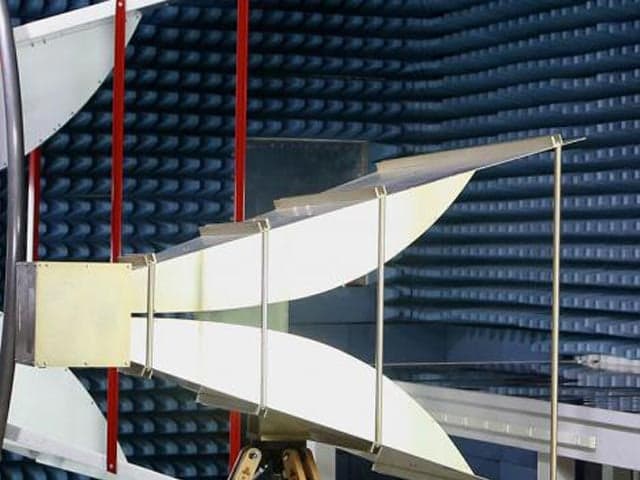DO-160 vs MIL-STD-461 for Aerospace & Defense applications
Fighter jets and attack helicopters are only two examples of Aerospace and Defense applications that must meet stringent MIL-STD-461 and RTCA DO-160 requirements for electromagnetic compatibility (EMC) and other environmental requirements. Preparation of your test system to these standards is provided with a long and complicated process. Read the article to help you understand the difference between the two standards and how to prepare for your test program.
Defense and Aerospace EMC test requirements
EMC testing requirements are based on the environments of intended use. As Defense and Aerospace products are often subjected to severe conditions and are critical in nature, thorough testing is essential. Susceptibility test levels and emissions limits will differ based on where the product is installed and used due to the variability of the intended environment.
For military installations, different test levels and limits are specified for installations on ground-based equipment, aircraft, ships, and submarines. Additionally, there are distinct limits for installations or use above or below decks on ships, and inside or outside an aircraft.
For civil aircraft equipment, susceptibility test levels vary greatly based on the function of the equipment. For example, critical navigation equipment is understandably subjected to much more stringent levels than a coffee maker or entertainment system. Emissions limits are based primarily on the location of the equipment inside or outside the fuselage, relative to the antennas used for the communications and navigation electronic systems.
DO-160 vs MIL-STD-461
MIL-STD-461
The EMC standard for military subsystems and equipment in the US is MIL-STD-461. Before MIL-STD-461, each branch of service had its own set of EMC requirements and tests. The original MIL-STD-461 was published in 1967; the most recent edition is MIL-STD-461G, published in 2015. Although MIL-STD-461 is required for US military programs, it is also the de facto EMC standard for defense projects all around the world, with a few exceptions.
MIL-STD-461 includes multiple test methods broken into four parts:
- Conducted emissions
- Conducted susceptibility
- Radiated emissions
- Radiated susceptibility
For avionics, conducted and radiated emissions tests are always required, but the applicability of any susceptibility test method depends on its installation and purpose. In general, more vital avionics (communication, navigation, flight control) will require more tests at higher levels.
RTCA DO-160
In the US and a large part of the world, RTCA DO-160 is the EMC standard for civil aircraft (avionics).
DO-160 was first published by RTCA in 1975, with the most recent edition being DO-160G, published in 2010. In Europe, the document is published as ED-14G, by EUROCAE, the sister organization to RTCA. Both documents are identical in all ways except the title.
DO-160, unlike MIL-STD-461, includes environmental tests such as temperature, humidity, and vibration, along with power quality and EMC tests. As with MIL-STD-461, the DO-160 includes multiple test methods for:
- Conducted emissions
- Conducted susceptibility
- Radiated emissions
- Radiated susceptibility
In addition to these tests, DO-160 also includes requirements for power quality and direct effects of lightning, which are covered by different standards for military applications. Each military service (Army, Air Force, or Navy) has a different list of required test methods based on the application of the equipment.
The importance of an approved test plan
Creating a test plan is the most valuable preparation you can do for testing. Having your test plan approved before testing is a requirement for larger military or aerospace contractors. For those who already have a test plan, our team can review your current plan to ensure you're properly prepared.
How to make test prep easier
The sooner you consider testing, the easier testing will be. Element’s military and aeronautical test engineers are here to assist you, whether you need help creating or reviewing your test plan or preparing your products, so you have a better chance of passing testing the first time. Pre-compliance scans are beneficial to our customers because time is valuable when it comes to testing.
The pre-compliance scan
Pre-compliance scans are a great tool to get a feel for how your device will perform during final testing. Stop by one of our locations to run scans for key tests to discover areas that might need improvement. Necessary modifications are much simpler and more affordable to make if they are discovered earlier in your development cycle.
How can Element help?
Element offers accredited MIL-STD-461 and RTCA DO-160 testing at multiple locations across the US and the UK. Our experts understand the unique requirements for Defense and Aerospace Electromagnetic Compatibility (EMC) testing and will work with you to provide the testing that you need for your projects. Contact us today for more information about Defense and Aerospace testing at Element.
Related Services

MIL-STD-461 Testing Services
Access accredited MIL-STD-461 testing with secure ITAR handling at our specialized military EMC testing facilities. Our MIL-STD-461G testing validates defense systems up to 70 tons with 200V/m capability.

Defense Product and System Testing Services
Element has over 50 years of experience working with a wide range of Defense Product and System manufacturers from the initial concept of their products and on to the complex testing that is required of modern defense equipment.

Aerospace EMI/EMC Testing
Element's aerospace EMI/EMC testing helps you meet commercial and military standards with tailored test plans, advanced facilities, and expert guidance to tackle compliance challenges and reduce delays.

DEF STAN 59 411 EMC Testing
Accelerate your defense qualification with Element's DEF STAN 59-411 environmental testing. Our accredited labs deliver complete military testing across all domains. Fast turnaround times for critical projects.

